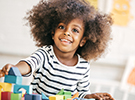Bears in a Bucket
In this lesson, children will weigh and compare the Bear Family Counters using a balance.
Lesson for:
Toddlers/Preschoolers
(See Step 5: Adapt lesson for toddlers or preschoolers.)
Content Area:
Measurement
Learning Goals:
This lesson will help toddlers and preschoolers meet the following educational standards:
- Understand measurable attributes of objects and the units, systems and processes of measurement
Learning Targets:
After this lesson, toddlers and preschoolers should be more proficient at:
- Using a balance to measure weight, using nonstandard units

Bears in a Bucket
Lesson plan for toddlers/preschoolers
Step 1: Gather materials.
- Bear Family Counters (If you do not have the Bear Family Counters, other small items may be used.)
- Bucket balance
- Pennies or other materials that can be used with the balance to measure weight, using a nonstandard measure
- Paper/pens
- Book: Berenstain Bears’ Big Bear, Small Bear
Note: Small parts pose a choking hazard and are not appropriate for children age five or under. Be sure to choose lesson materials that meet safety requirements.
Step 2: Introduce activity.
- Read: The Berenstain Bears’ Big Bear, Small Bear. This book will support the concepts of bigger and smaller.
- Show the children the Bear Family Counters.
- Ask: “What do you notice about the bears?”
- Explain that there are different-sized bears in the families.
- Ask children to identify which bears are small and which bears are big.
- Allow the children to simply explore the counters before introducing the bucket balance.
- Ask the children to predict if they think the big bears weigh more than, less than or the same as the small bears.
Step 3: Engage children in lesson activities.
- Take out the bucket balance.
- Introduce the bucket balance and explain that it can be used to weigh small things. Show how the bucket balance works.
- Place the bucket balance on the table and work with the children in small groups to balance the bears.
- Invite the children to place equal numbers of large bears on one side of the balance and equal numbers of small bears on the other side of the balance.
- Observe the children’s reactions to the bucket balance.
- Ask the children for ideas about how to make the bucket balance.
- Offer other ideas about placing different numbers of bears on each side, mixing the sizes and numbers while seeking balance.
- Extend the activity by introducing other objects that children can use to balance with the bears (e.g., pennies). For example, place two big bears in one bucket and ask the children to add pennies to the other bucket until it is balanced. Then ask the children to state the result: “Two big bears weigh the same as ___ pennies.”
- Challenge the children by asking them to think of big things (e.g., a large balloon) that do not weigh much and small things that weigh a lot (e.g., steel marbles or dense pebbles).
Step 4: Vocabulary.
- Heavier: Having more weight
- Lighter: Having less weight
- More than: A value that is higher or greater in number
- Less than: A value that is smaller in number
- Balance: To make equal or to be equal
- Same: Identical in kind or quantity
- Different: Unlike
- Weigh: To measure according to weight
- Estimate: To form an approximate judgment or opinion regarding amount, worth, size, weight, etc.; to calculate approximately
- Predict: To guess what will happen next
Step 5: Adapt lesson for toddlers or preschoolers.
Adapt Lesson for Toddlers
Toddlers may:
- Play with the bears
- Simply guess at the predictions
- Not be able to tell when the buckets are balanced
Child care providers may:
- Encourage the children to play with the bears and the bucket balance together
- Support the toddlers’ guesses with supportive words and allow them to guess and check their guesses using the bears and the bucket balance
Adapt Lesson for Preschoolers
Preschoolers may:
- Want to place other objects on the bucket balance
Child care providers may:
- Provide a variety of small objects that can be placed on the bucket balance
Suggested Books
- Big Bear, Little Bear by Jan Berenstain and Stan Berenstain ( New York: Random House, 1998)
- Big Dog, Little Dog by P.D. Eastman (New York: Random House, 1973)
- Me and the Measure of Things by Joan Sweeny and Annette Cable (New York: Dragonfly Books, 2001)
Music and Movement
Outdoor Connections
- Bring the bucket balance outdoors to weigh small found objects.
- Collect small items from outside (pebbles, twigs, acorns, etc.) to bring into the classroom to weigh and compare weight and balance with bears.
Comment on this lesson